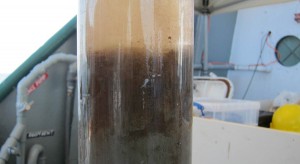Deep Sea Fish and Sediment Surveys in the Gulf
Meet C-IMAGE Scientist: David Hastings
Dr. David Hastings is a marine chemist and Professor at Eckerd College. Enjoy Hastings photo story as he shares his science contribution to the C-IMAGE project.
Following the oil spill, we are very interested in both the fate and transport of the oil. Where did it go? We think that some of it went into the ocean sediments, and we want to know the eventual demise of the oil. We collect sediments (aka mud) from the ocean bottom in order to try and answer these questions using an instrument called a multi-corer. Note that there are 8 separate core barrels since there are many different scientists who want the samples.
We first need to transfer the sediment from one core liner to another. We store the sediment for many analyses that are done later back in the lab on shore.
Even though there is no light in ocean sediments at the depths we are sampling, there is still some life at the ocean floor. What do you think these organisms are?
After the oil spill, there was a large pulse of sedimentation from the surface waters that has a different coloration from the sediments beneath. The rate of sedimentation following the oil spill is 100 times greater than before!
The water in the sediments is important to fully understand the chemical processes involved in the decomposition of oil and other organics. Here I am using a set of syringes to suck water out of the mud for later analysis. I am eager to find out the results of this experiment!
| Print article | This entry was posted by greely on August 18, 2012 at 11:36 pm, and is filed under Oceanic Updates. Follow any responses to this post through RSS 2.0. You can leave a response or trackback from your own site. |






